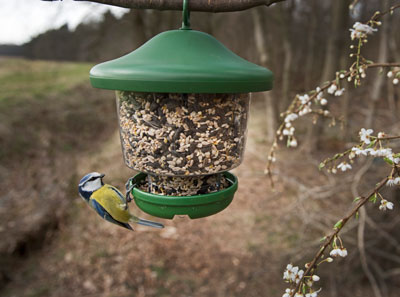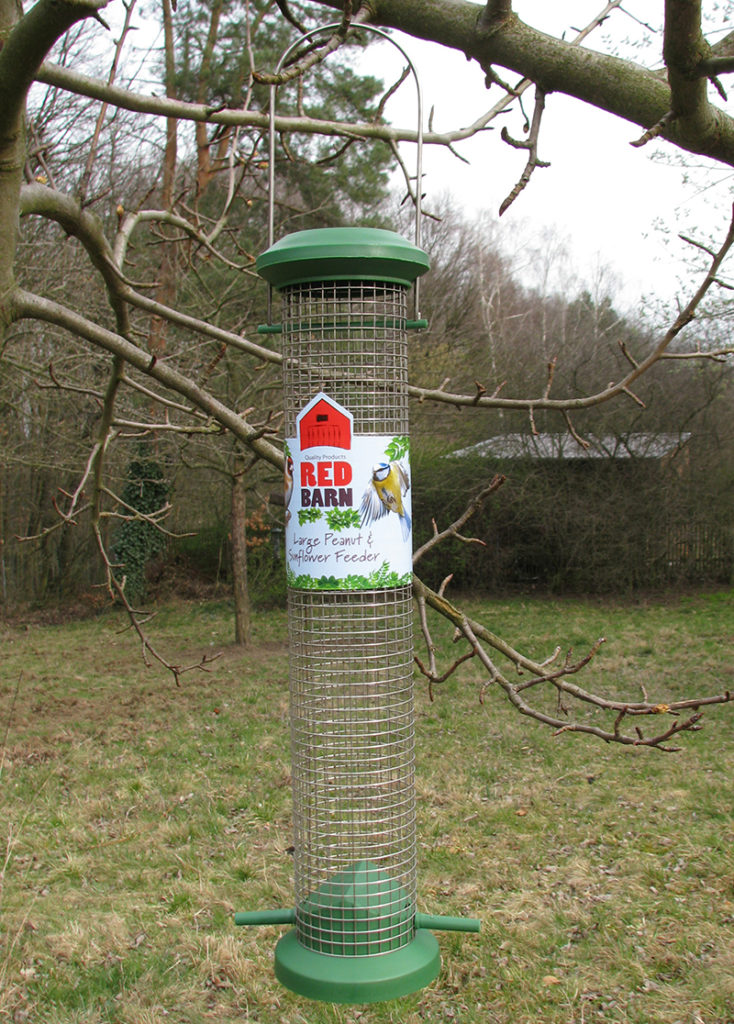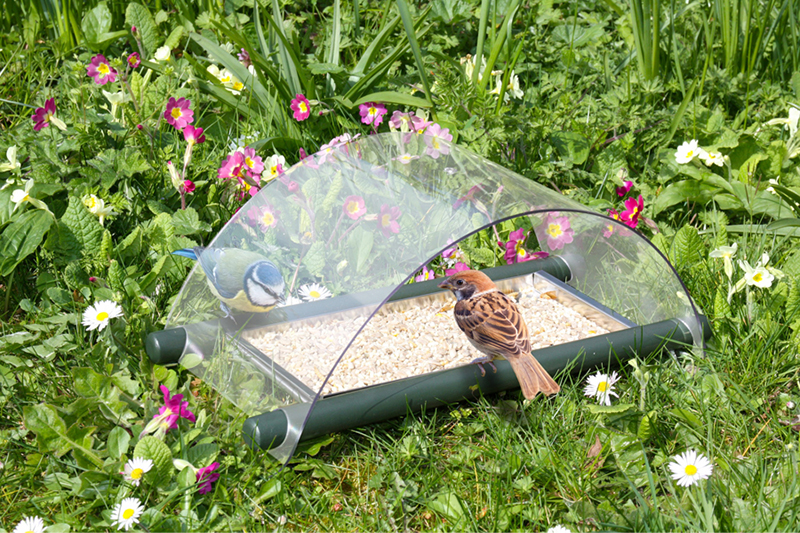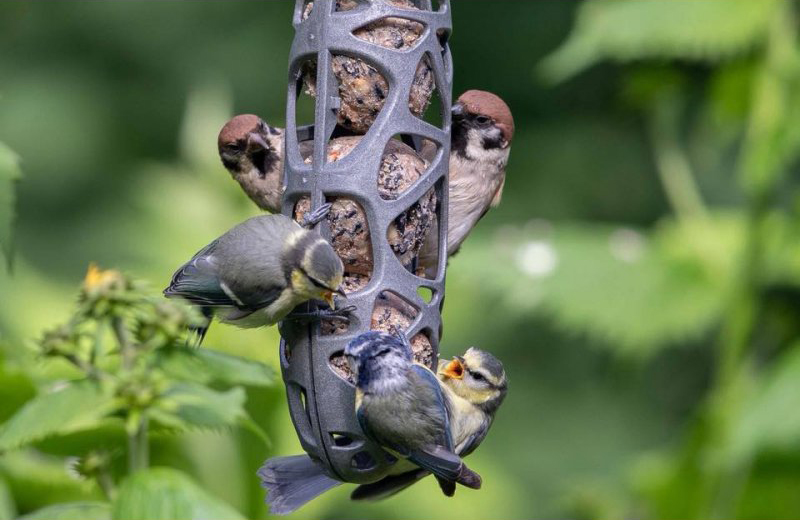Some birds are quite adaptable creatures, happy for every scrap of food and don’t care much about the shape of the feeding structure. Certain birds exist, however, that feed predominantly on the ground or need more room on a bird table to even consider it. If you want to attract as many different species as possible to your garden, you need to think about their requirements in terms of content and the form of the bird table.
Where to place a bird table
In a garden, it’s best to fit the bird table on a tree or near shrubs (but beware of lurking cats!). If you have a garden near a forest or orchard, that’s even better. This environment could be described as “meeting birds halfway” – that is, putting the bird table where birds typically visit and their natural habitat.
Owners of flats can place a bird table on the balcony, window sill or a tree that is observable from a window (so you don’t miss out on the action). Bird tables with suction cups for attaching them to glass are even available.
The more varied the feeding sites that are created, the more birds you will see at them. By having several feeding sites, there won’t be any waiting around by birds that fear other types or can’t tolerate them.
TYPES OF FEEDERS
Tube and dispenser feeders
This type of feeder is filled from above and seeds gradually fall out at the bottom as the birds collect them. There are tubes with standard holes and then special tubes adapted FOR really small seeds (e.g. niger seeds). Dispenser feeders work on the same principle as tube feeders except they are a different shape and have a larger pedestal in which the feed accumulates for birds pick at.

Dispensers have the advantage that you can easily put large quantities of feedstuffs in them as a reserve. However, in rain and snow, there is a risk that moisture will enter the bottom and will be difficult to dry.
Birds that visit tube feeders: Tits, the House Sparrow, Spotted Woodpecker, Greenfinch, European Siskin, Wood Nuthatch, European Starling and Goldfinch – a species that loves dispensers containing small seeds, such as niger.
Nut dispensers
Wire-wall feeders, they are mainly used for peanuts. Birds peck at the feed through the screen, but they are unable to get the whole nut out. This acts as a measure against “theft”.

Species happy to visit one: the European Robin, European Siskin, Tits, Spotted Woodpecker, Wood Nuthatch, Sparrow and Hawfinch.
Conventional roofed bird tables
Typically suspended or mounted on a post, the drawback is that birds sit in the feed and sometimes defecate in it, so it’s necessary to clean the surface frequently. The recommendation is to opt for a bird table that is removable, or one that has a detachable base so it’s easy to clean and dry. Roofed bird tables come in various sizes and shapes.
If there’s an abundance of birds, you’ll need one with sufficient surface area (up to 0.25 square metres); allow a height of about 30 cm between the roof and the base to attract shy species such as the Hawkfinch, Goldfinch and Chaffinch. A bird table should be a sizeable unit, suitable for sites with a lot of visiting birds.
Almost all birds are happy to pop by a bird table.
Elevated feeding tables
A plate without a roof, placed on a stand at a height. The feed is spread over this area. The same applies here as for bird tables – it’s necessary to clean the feeding area frequently.
These attract the Eurasian Blackbird, Song Thrush, Dunnock, Eurasian Wren, White Wagtail, Chaffinch, Greenfinch and European Starling.
Feeding on the ground
A roofed or open bird table. Birds take food directly from the ground or from a board on the ground. If putting feed on the ground without any roof covering the site, take moisture and mould into account, which are rapid in onset.

Birds that feed on the ground are the Yellowhammer, Woodlark, Chaffinch, Linnet, Grey Partridge, Pheasant, Common Moorhen, Green Woodpecker, Eurasian Blackbird, Fieldfare, Eurasian Collared-dove, Common Wood Pigeon, White Wagtail, Titlark, Tree Pipit, Common Magpie, Eurasian Jay and Raven.
Suet balls and cakes
Shops still sell suet balls in a net, which bird enthusiasts aren’t fans of because of the risk of a bird getting entangled in the net. In addition, the nets end up on the ground and there’s a risk another animal will eat them. However, some suet balls are available without nets that are put into holders and hung out for birds. Another option is a suet cake that’s unwrapped and placed in a special holder.

Suet balls and cakes are appreciated by the European Robin, Tits, Wood Nuthatch, European Siskin, Long-tailed Tit, Goldcrest, Greenfinch, Sparrow, Spotted Woodpecker and Black Woodpecker.
Special requirements
There are also birds that prefer their own way of feeding.
For example, Goldcrests like a fatty feed mixture that is pushed into bark or twigs. Spotted Woodpeckers feed on that pressed into bark, as do nuthatches; pressing the feed into holes in the wood is also an option.
Short-toed Tree Creepers like a fatty feed mixture near a tree trunk.
Blackcaps prefer a fat-based feed with berries hidden away in shrubs.
The more varied the food offered to birds, the more species you are likely to see, and more variety is also encouraged through having different types of feeders. It is obvious that some birds prefer feeding tables that emulate their feeding habits as closely as possible. Why not start out with a bird table and add other types of feeding stations on an ad hoc basis? Any additions to the arrangement depend on what birds inhabit your part of the world.
